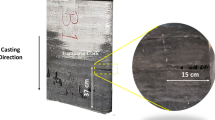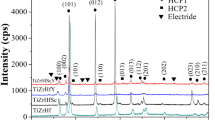Abstract
The aim of this study is to investigate mechanical and microstructural variations of Ti–6Al–4V acquired through various equal channel angular pressing (ECAP) cycles. The ECAP of Ti–6Al–4V alloy with the first equiaxed microstructure was carried out by an isothermal warm and isothermal die method. ECA pressing carried out on cylindrical samples at 650 °C. Mechanical and microstructural investigations were performed concerning Ti–6Al–4V in the first state after 2, 4, and 8 passes. Optical microscopy (OM) investigation shows that alpha grain size increases and beta grain size decreases with the pass numbers increasing. Beta phase content initially decreases in the first two ECAP passes. The results show that more equiaxed alpha grains are achieved after four ECAP passes. Results of X-ray diffraction (XRD) analysis show that crystallite size decreases with the number of passes increasing. After two ECAP passes, a vivid increase in mechanical strength is observed; however, the increment dramatically slows down by the increasing number of passes.













Similar content being viewed by others
References
Semenova IP, Raab GI, Saitova LR, Valiev RZ. The effect of equal-channel angular pressing on the structure and mechanical behavior of Ti–6Al–4V alloy. Mater Sci Eng. 2004;387:805.
Semenova IP, Raab GI, Golubovskiy ER, Valiev RR. Service properties of ultrafine-grained Ti–6Al–4V alloy at elevated temperature. J Mater Sci. 2013;48(13):4806.
Kim SM, Kim J, Shin DH, Ko YG, Lee CS, Semiatin SL. Microstructure development and segment formation during ECA pressing of Ti–6Al–4V alloy. Scr Mater. 2004;50(7):927.
Langdon TG. Twenty-five years of ultrafine-grained materials: achieving exceptional properties through grain refinement. Acta Mater. 2013;61(19):7035.
Edalati K, Horita Z. A review on high-pressure torsion (HPT) from 1935 to 1988. Mater Sci Eng A. 2016;652:325.
Huang Y, Langdon TG. Advances in ultrafine-grained materials. Biochem Pharmacol. 2013;16(3):85.
Zhu YT, Lowe TC, Langdon TG. Performance and applications of nanostructured materials produced by severe plastic deformation. Scr Mater. 2004;51(8):825.
Valiev RZ, Estrin Y, Horita Z, Langdon TG, Zehetbauer MJ. Producing bulk ultrafine-grained materials by severe plastic deformation: ten years later. JOM. 2016;68(4):1216.
Semiatin SL, Delo DP. Equal channel angular extrusion of difficult-to-work alloys. Mater Des. 2000;21(4):311.
Azushima A, Kopp R, Korhonen A, Yang DY, Micari F, Lahoti GD, Groche P, Yanagimoto J, Tsuji N, Rosochowski A, Yanagida A. Severe plastic deformation (SPD) processes for metals. CIRP Ann Manuf Technol. 2008;57:716.
Froes FH. Titanium Physical Metallurgy Processing and Applications. Ohio: ASM International; 2015. 1.
Guven G, Karaman I. Mechanical twinning and texture evolution in severely deformed Ti–6Al–4V at high temperatures. Acta Mater. 2006;54(14):3755.
Delo DP, Semiatin SL. Hot working of Ti–6Al–4V via equal channel angular extrusion. Metall Mater Trans A. 1999;30(9):2473.
Ko YG, Jung WS, Shin DH, Lee CS. Effects of temperature and initial microstructure on the equal channel angular pressing of Ti–6Al–4V alloy. Scr Mater. 2003;48:197.
Semenova IP, Saitova LR, Raab GI, Korshunov AI. Microstructural features and mechanical properties of the Ti–6Al–4V ELI alloy processed by severe plastic deformation. Mater Sci Forum. 2006;504:757.
May L. Mechanical Properties of Ultrafine-Grained Ti–6Al–4V ELI Alloy Processed by Severe Plastic Deformation. Erlangen: Friedrich-Alexander-Universität Erlangen-Nürnberg; 2009. 1.
Langdon TG. The principles of grain refinement in equal-channel angular pressing. Mater Sci Eng A. 2007;462(1–2):3.
Zhang T, Liu Y, Sanders DG, Liu B, Zhang W, Zhou C. Development of fine-grain size Ti–6Al–4V alloy sheet material for low temperature superplastic forming. Mater Sci Eng A. 2014;608(25):265.
Stolyarov VV, Zhu YT, Alexandro IV, Lowe TC, Valie RZ. Grain refinement and properties of pure Ti processed by warm ECAP and cold rolling. Mater Sci Eng A. 2003;343(1–2):43.
Valiev RZ, Langdon TG. Principles of equal-channel angular pressing as a processing tool for grain refinement. Prog Mater Sci. 2006;51(7):881.
Semenova IP, Polyakov AV, Polyakova VV, Huang Y, Valiev RZ, Langdon TG. High-cycle fatigue behavior of an ultrafine-grained Ti–6Al–4V alloy processed by ECAP and extrusion. Adv Eng Mater. 2016;18(12):2057.
Gun Y, Young D, Hyuk D, Lee S, Soo C. Factors influencing the equal-channel angular pressing of Ti–6Al–4V alloy having lamellar microstructure. Mater Sci Eng A. 2008;493(1):164.
Latysh VV, Semenova IP, Salimgareeva GH, Kandarov IV, Lowe TC, Valiev RZ. Microstructure and properties of Ti rods produced by multi-step SPD. Mater Sci Forum. 2006;504:763.
Xu C, Langdon TG. The development of hardness homogeneity in aluminum and an aluminum alloy processed by ECAP. J Mater Sci. 2007;42(5):1542.
Latysh V, Krallics G, Alexandrov I, Fodor A. Application of bulk nanostructured materials in medicine. Curr Appl Phys. 2006;6(2):262.
Azushima A, Kopp R, Korhonen A, Yang DY, Micari F, Lahoti GD, Groche P, Yanagimoto J, Tsuji N, Rosochowski A, Yanagida A. Severe plastic deformation (SPD) processes for metals. Manuf Technol. 2008;57(2):716.
Hosseini SA, Manesh HD. High-strength, high-conductivity ultra-fine grains commercial pure copper produced by ARB process. Mater Des. 2009;30(8):2911.
Keshavarz MK. Microstructural evolution, mechanical properties, and strain hardening behavior of ultrafine grained commercial pure copper during the accumulative roll bonding process. Mater Sci Eng A. 2015;650:8.
Li Z, Sun Y, Lavernia EJ, Shan A. Mechanical behavior of ultrafine-grained Ti–6Al–4V alloy produced by severe warm rolling: the influence of starting microstructure and reduction ratio. Metall Mater Trans A. 2015;46(11):1.
Acknowledgements
This study was financially supported by Amirkabir University of Technology (No. 40.509). The authors are grateful to R. Mortezaei for their help with experiments. The authors would also like to thank the precision forming group at the Malek Ashtar University of Technology for performing ECAP experiments.
Author information
Authors and Affiliations
Corresponding author
Rights and permissions
About this article
Cite this article
Arabi, H., Ketabchi, M. & Alhosseini, S.H.N. Mechanical and microstructural variations in ECAP of Ti–6Al–4V alloy with equiaxed microstructure. Rare Met. 41, 2732–2738 (2022). https://doi.org/10.1007/s12598-018-1071-5
Received:
Revised:
Accepted:
Published:
Issue Date:
DOI: https://doi.org/10.1007/s12598-018-1071-5




